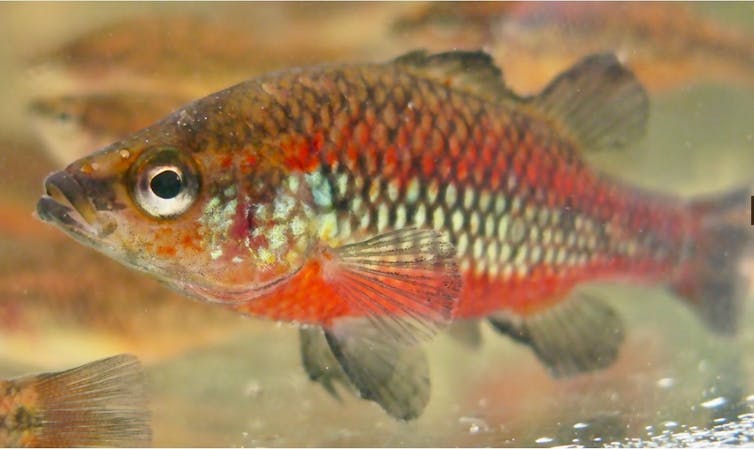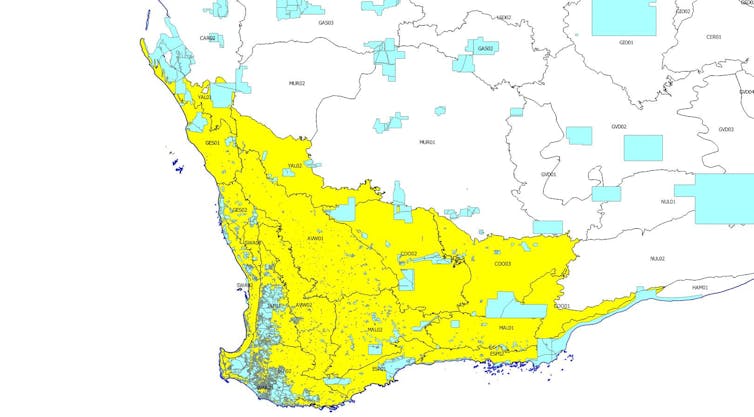
Climate change threatens plants and animals around the world, but some regions are particularly exposed. Some are vulnerable simply due to the huge diversity of species they harbour. Others will experience more acute climate disruption than elsewhere. For some regions, such as Western Australia’s southwest, both are true.
WA’s southwest is a globally recognised “biodiversity hotspot”. Such regions have exceptionally high numbers of “endemic” species – those not found anywhere else – and have experienced significant habitat loss. And alarmingly, the region is fast becoming hotter and drier.
Our new research shows how climate stability in the past allowed ancient populations of small freshwater fish to persist today, despite their isolation. This stability is now at risk as climate change worsens, suggesting tough times ahead for these fish populations.
As the planet warms, ambitious conservation actions are urgently needed to save the iconic biodiversity of WA’s southwest – one of Australia’s natural treasures.

A hotspot for life
There are only two biodiversity hotspots in Australia: the coastal forests of eastern Australia, and southwest WA. The latter spans more than 356,000 square kilometres from Shark Bay to Esperance. It is home to more than 8,000 species of plants, over half of which are endemic. Its animal diversity is similarly impressive.
So how did southwest WA become such a melting pot of biodiversity? Scientists have proposed several reasons.
First, the surrounding arid land isolates it from the rest of Australia, which allowed a unique suite of species to assemble. Second, its landscape and species are ancient – many tracing back to Gondwanan origins. This suggests biodiversity has accumulated for hundreds of millions of years.
And finally, parts of this region have been protected against climate change for millions of years, including during glacial periods, due to a current carrying warm water down Western Australia’s coast. This climate stability is particularly relevant today.
Since the 1970s, rainfall in southwest WA has decreased by up to 15%, and is set to worsen in the near future. Annual temperatures have increased by more than 1°C since the start of the 20th century.
That raises an important question: if species in the region haven’t experienced much climate change in the past, can they cope with it now? Our research set out to answer this question by examining freshwater fish.

A surprising discovery
We used molecular ecology approaches, which combine genetic information with ecological and environmental data. We focused on two small freshwater fish species endemic to southwest WA – the western and little pygmy perches.
Our previous research showed these remarkable species have existed in the landscape for millions of years, despite not being able to move very far. They made ideal candidates for understanding how climate history might have shaped evolution.
We obtained genomic data from populations of these fish across southwest WA. From this, we determined their evolutionary histories, such as how long ago they last shared a common ancestor, and whether their populations had been connected in the past. Separately, using computer modelling, we investigated how past climates had affected where the species lived, and how this might change in future.
So what did we find? The populations of pygmy perches were very genetically distinct from each other. In fact they were so distinct, it is likely they comprise at least three, rather than two, different species.
We found two separate lineages of western pygmy perches. The analysis showed these lineages, despite looking physically similar, last shared an ancestor about nine million years ago. This suggests they should be classed as two distinct species, and the conservation status of both species should be reassessed.
Our genomic results also suggest these divergent populations of pygmy perches must have persisted in the landscape for millions of years. Our climate modelling supported this conclusion.
Our reconstructions of past climate found little evidence for large changes in the distribution of these species in the last three million years. This reflects the general stability in the climate over that time, which allowed these isolated populations to persist and form distinct lineages.

What about future climate change?
Unfortunately, things started to look dire when we looked at predictions under future climate changes. Large declines in ranges for the fish species were predicted in the coming decades.
For one of the western pygmy perch species, this included a total loss of suitable habitat by about 2070 under a “business-as-usual” scenario – that is, a scenario where no further efforts to reduce global carbon emissions are made.
Sadly, the effects of climate change on other freshwater species in this region are already being felt. Recent drying of streams has caused a decline in ancient insect species. And less winter-spring rainfall in the region is projected to reduce spawning in freshwater fish populations.
Drying and warming is also reducing the availability and quality of natural refuge pools, which most freshwater fish rely on to survive the dry season.
So what can be done? First, it’s important to make rivers and streams as healthy as can be. That includes restoring and protecting banks, and considering the needs of aquatic species when extracting water.
We must also prevent more non-native fish species from entering waterways, and explore the conservation potential of artificial aquatic refuges such as ponds and dams. And more drastic interventions, such as moving populations to new locations, may also be required.
Of course, reducing our carbon emissions will be crucial for the survival of biodiversity, especially freshwater fish, across the globe.
Climate change poses an existential threat to southwest WA’s unique natural environment and the species within it. Swift, broad-ranging action is needed to avoid tragic losses.
Luciano Beheregaray receives funding from the Australian Research Council.
Mark Allen receives funding from The Ian Potter Foundation for the project investigating the use of fire-fighting waterpoints as conservation refuges.
Stephen Beatty receives funding from The Ian Potter Foundation for the project investigating the use of fire-fighting waterpoints as conservation refuges.
Sean Buckley does not work for, consult, own shares in or receive funding from any company or organisation that would benefit from this article, and has disclosed no relevant affiliations beyond their academic appointment.
This article was originally published on The Conversation. Read the original article.







